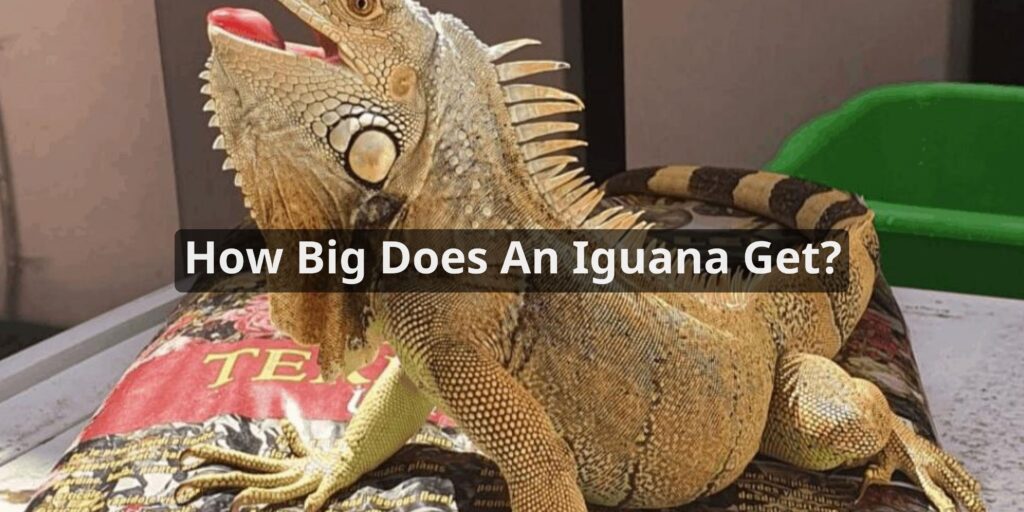Iguanas are a popular exotic pet that can grow quite large. In their native habitats of Central and South America, iguanas can reach impressive sizes thanks to abundant food sources and tropical environments. For iguana owners, it’s important to understand just how big does an iguana get to properly care for them.
Typical Adult Size

The most common pet iguana is the green iguana, also known as the common iguana. Green iguanas are large lizards that can grow up to 6 feet long from head to tail and weigh around 20 pounds. Their bodies alone without the tail can reach 3 feet in length.
Other iguana species popular as pets include:
- Rhinoceros iguana – Up to 5 feet long and 10-20 pounds
- Blue iguana – Around 5 feet long and up to 30 pounds
- Spiny-tailed iguana – Up to 3.5 feet long
So in general, most pet iguana species have the potential to reach 4-6 feet in total length from head to tail and weigh anywhere from 10-30 pounds depending on the species. Their size is impressive compared to other common pet lizards.
Factors That Determine Size
An iguana’s ultimate size depends on several factors:
Age
Iguanas grow rapidly when young but their growth slows significantly once they reach maturity around 2-4 years old. They continue growing slowly throughout life. Most of their size is reached within the first 5 years.
Gender
Male iguanas tend to grow larger than females of the same species.
Species
Some iguana species naturally remain smaller than others. For example, spiny-tailed iguanas don’t grow as large as green or blue iguanas.
Diet & Environment
Abundant food, warmth, UVB light, and proper habitat contribute to an iguana reaching its full growth potential. Iguanas raised in captivity often grow larger than wild ones due to consistent ideal conditions.
Caring for a Large Iguana
Iguanas this size require specialized care and major commitments from owners. Here are some considerations:
- Housing: A full-grown iguana needs an entire room or at minimum a 6 foot x 3 foot x 6 foot enclosure. Proper lighting and temperature gradients must be provided.
- Food: Adult iguanas eat large amounts of leafy greens, vegetables, and other produce daily. Variety is important for nutrition.
- Handling: Large iguanas can be difficult to handle safely. Their whip-like tails can injure humans. Heavy gloves are recommended.
- Veterinary Care: Exotic vets are needed to provide checkups and medical care, which gets costly for giant lizards. Health issues like metabolic bone disease are concerns.
- Expenses: From housing and food to vet bills, these giants are a major, lifelong financial commitment. Proper care costs thousands per year.
Key Takeaways
To summarize key points about full-grown iguanas:
- Most common pet iguana species reach 4-6 feet long including their tails, with weights from 10-30 pounds depending on species.
- Iguanas grow quickly when young but slow down significantly once mature. Most of their size is reached in the first 5 years.
- Males tend to grow bigger than females. Diet, environment, genetics, and species impact size too.
- Giant adult iguanas need massive enclosures, lots of food, special handling, and exotic veterinary care. They are a major commitment!
So in answering “how big does an iguana get?”, they truly become giant lizards at maturity. Understanding their full adult size and needs is essential for anyone considering one of these reptiles as a pet.
FAQs About How Big Does An Iguana Get
Do male and female iguanas grow to different sizes?
In most iguana species, males tend to be slightly larger than females, but the difference in size is not significant. Other physical characteristics, such as dewlaps and head shape, are more reliable indicators of gender.
What factors influence an iguana’s growth rate?
An iguana’s growth rate is influenced by factors like diet, temperature, and habitat conditions. A diet rich in nutrients, proper heating and lighting, and a spacious enclosure can promote healthy growth.
How long does it take for a baby iguana to reach its adult size?
Baby iguanas grow rapidly during their first few years of life. On average, it takes about 2 to 3 years for a baby iguana to reach its adult size, depending on species and environmental conditions.
What is the average size of a juvenile iguana?
The size of a juvenile iguana varies depending on its age and species. Generally, juvenile iguanas can range from a few inches to around a foot (30 centimeters) in length during their early years of growth.
Are there any growth-related health concerns for pet iguanas?
Yes, improper nutrition and care can lead to growth-related health concerns in pet iguanas. Inadequate diets or housing conditions may result in stunted growth, metabolic bone disease, or other health issues.
Can the size of an iguana be controlled through diet and habitat conditions?
While diet and habitat conditions can influence an iguana’s growth, there is a natural size range for each species. You can ensure healthy growth by providing proper nutrition and ideal living conditions, but you cannot significantly alter an iguana’s species-specific maximum size.



